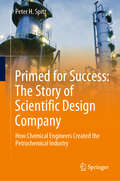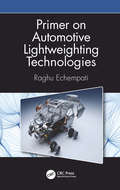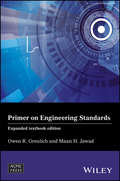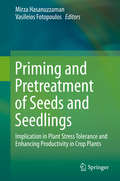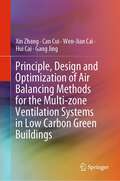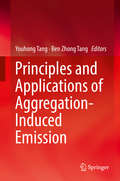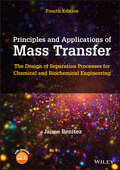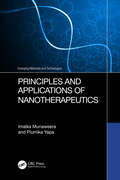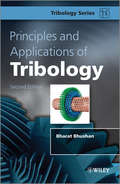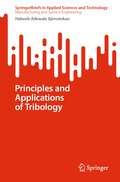- Table View
- List View
Prime Obsession: Bernhard Riemann and the Greatest Unsolved Problem in Mathematics
by John DerbyshireIn August 1859 Bernhard Riemann, a little-known 32-year old mathematician, presented a paper to the Berlin Academy titled: "On the Number of Prime Numbers Less Than a Given Quantity." In the middle of that paper, Riemann made an incidental remark -- a guess, a hypothesis. What he tossed out to the assembled mathematicians that day has proven to be almost cruelly compelling to countless scholars in the ensuing years. Today, after 150 years of careful research and exhaustive study, the question remains. Is the hypothesis true or false? Riemann's basic inquiry, the primary topic of his paper, concerned a straightforward but nevertheless important matter of arithmetic -- defining a precise formula to track and identify the occurrence of prime numbers. But it is that incidental remark -- the Riemann Hypothesis -- that is the truly astonishing legacy of his 1859 paper. Because Riemann was able to see beyond the pattern of the primes to discern traces of something mysterious and mathematically elegant shrouded in the shadows -- subtle variations in the distribution of those prime numbers. Brilliant for its clarity, astounding for its potential consequences, the Hypothesis took on enormous importance in mathematics. Indeed, the successful solution to this puzzle would herald a revolution in prime number theory. Proving or disproving it became the greatest challenge of the age.--It has become clear that the Riemann Hypothesis, whose resolution seems to hang tantalizingly just beyond our grasp, holds the key to a variety of scientific and mathematical investigations. The making and breaking of modern codes, which depend on the properties of the prime numbers, have roots in the Hypothesis. In a series of extraordinary developments during the 1970s, it emerged that even the physics of the atomic nucleus is connected in ways not yet fully understood to this strange conundrum. Hunting down the solution to the Riemann Hypothesis has become an obsession for many -- the veritable "great white whale" of mathematical research. Yet despite determined efforts by generations of mathematicians, the Riemann Hypothesis defies resolution. Alternating passages of extraordinarily lucid mathematical exposition with chapters of elegantly composed biography and history, Prime Obsession is a fascinating and fluent account of an epic mathematical mystery that continues to challenge and excite the world. Posited a century and a half ago, the Riemann Hypothesis is an intellectual feast for the cognoscenti and the curious alike. Not just a story of numbers and calculations, Prime Obsession is the engrossing tale of a relentless hunt for an elusive proof -- and those who have been consumed by it.
Primed for Success: How Chemical Engineers Created the Petrochemical Industry
by Peter H. SpitzThis is the remarkable story of an entrepreneurial firm that helped to create the petrochemical industry as we know it today. The author also highlights the important role chemical engineers played in developing and commercializing new technologies based on the conversion of hydrocarbons into petrochemicals, which also led to the transfer of technological dominance from Germany to the United States. These developments are illustrated by the participants’ personal histories, in the form of interviews and recorded oral histories. In addition, the book presents a highly relevant case study for engineers and managers in the chemical industry.
Primer on Automotive Lightweighting Technologies
by Raghu EchempatiAluminum is increasingly replacing steel in automotive applications due to its superior strength-to-weight ratio, equal or better stiffness and toughness properties, durability, and manufacturability considerations. Primer on Automotive Lightweighting Technologies introduces basic ideas and principles of designing and engineering automotive components with aluminum. Topics include application of the knowledge to understand how automotive body and structures are designed, as well as other major and smaller automotive components, such as engine blocks and their components, chassis systems, and wheels, to name a few. Discusses material considerations in engineering design Describes mechanical and physical properties of aluminum Covers manufacturing methods and automotive and industrial applications of aluminum products Offers information on design for functional performance and cost optimization Includes coverage of extruded and rolled products and car body structure This practical book is aimed at professionals in the fields of materials and mechanical engineering, automotive engineering, and metals and alloys, as well as advanced students and researchers.
Primer on Composite Materials Analysis (revised)
by John C. HalpinThis outstanding reference presents an up-to-date account of investigations during the last 10 years in the area of injection and compression molding of polymers.Injection and Compression Molding Fundamentals considers simulation andexperimentation of flow dynamics in the cavity and delivery system . . . discussesrheology and viscoelastic modeling ... clarifies fiber orientation ... delineates residualstresses and processing-property relationships in molded parts ... and details computeraideddesign and manufacture of the mold.In addition, the book highlights specific features and problems related to the molding ofthermoplastics, rubbers, and thermosets ... and reveals the current status of the sciencebasedtechnology related to injection and compression molding.The most detailed and authoritative reference of its type, Injection and CompressionMolding Fundamentals is an invaluable resource for plastics, mechanical, andchemical engineers; colloid, oil, and color chemists; polymer engineers and scientists;mold designers and manufacturers; rheologists; and materials scientists. The book willalso be of value for use in graduate-level courses in plastics, mechanical, chemical, andpolymer engineering, and in short courses and seminars offered by professional societies.
Primer on Engineering Standards: Expanded Textbook Edition (Wiley-ASME Press Series)
by Maan H. Jawad Owen R. GreulichA Clear, Comprehensive Introduction to Standards in the Engineering Professions Standards supplement the design process by guiding the designer toward consistency, safety, and reliability. As daily life involves increasingly complex and sophisticated instruments, standards become indispensable engineering tools to ensure user safety and product quality. Primer on Engineering Standards: Expanded Textbook Edition delves into standards creation and compliance to provide students and engineers with a comprehensive reference. The different types of standards are dissected and discussed in terms of development, value, impact, interpretation, and compliance, and options are provided for situations where conformance is not possible. The process of standards creation is emphasized in terms of essential characteristics and common pitfalls to avoid, with detailed guidance on how, where, and with whom one may get involved in official development. Organized for both quick reference and textbook study, this new Expanded Textbook Edition provides a quick, clear understanding of critical concepts, ramifications, and implications as it: Introduces the concepts, history, and classification of standards, rules, and regulations Discusses the federal, state, and local government’s role in standards development and enforcement Distinguishes voluntary consensus standards, limited consensus standards, and jurisdictional versus non-jurisdictional government standards Covers the need for and process of exemptions to existing standards Examines the characteristics of a good standard, and discusses opportunities for involvement in development Includes case studies to demonstrate standards applications, and extensive appendices to direct further inquiry The successful design, fabrication, and operation of any product relies on foundational understanding of pertinent standards; indeed, standards and guidelines form a central pillar of the engineering profession. This helpful resource goes beyond a list of rules to help students and practitioners gain a better understanding of the creation, import, and use of standards.
Primer on Risk Analysis: Decision Making Under Uncertainty
by Charles YoePrimer on Risk Analysis: Decision Making Under Uncertainty, Second Edition lays out the tasks of risk analysis in a straightforward, conceptual manner, tackling the question, "What is risk analysis?" Distilling the common principles of many risk dialects into serviceable definitions, it provides a foundation for the practice of risk management and decision making under uncertainty for professionals from all disciplines. New in this edition is an expanded risk management emphasis that includes an overview chapter on enterprise risk management and a chapter on decision making under uncertainty designed to help decision makers use the results of risk analysis in practical ways to improve decisions and their outcomes. This book will empower you to enter the world of risk management in your own domain of expertise by providing you with practical, insightful, useful and adaptable knowledge of risk analysis science including risk management, risk assessment, and risk communication. Features: Answers the fundamental question, "What is Risk Analysis?" Presents the tasks of risk management, risk assessment, and risk communication in a straightforward, conceptual manner Responds to the continuing evolution of risk science and addresses the language of risk as it continues to evolve Expands the risk management emphasis with a new chapter to serve private industry and a growing public sector interest in the growing practice of enterprise risk management Includes a new chapter on decision making under uncertainty provides practical guidance and ideas for using risk science to improve decisions and their outcomes Features an expanded set of examples of the risk process that demonstrate the growing applications of risk analysis This book is suitable for executives, professionals and students who seek a fundamental understanding of risk management, risk assessment, and risk communication. A more detailed examination of this topic, suitable for practitioners from any discipline as well as students and professionals who aspire to become experts in the practice of risk analysis science, is found in Principles of Risk Analysis: Decision Making Under Uncertainty, Second Edition, ISBN: 978-1-138-47820-6.
Priming and Pretreatment of Seeds and Seedlings: Implication in Plant Stress Tolerance and Enhancing Productivity in Crop Plants
by Mirza Hasanuzzaman Vasileios FotopoulosThis book introduces readers to both seed treatment and seedling pretreatments, taking into account various factors such as plant age, growing conditions and climate. Reflecting recent advances in seed priming and pretreatment techniques, it demonstrates how these approaches can be used to improve stress tolerance and enhance crop productivity. Covering the basic phenomena involved, mechanisms and recent innovations, the book offers a comprehensive guide for students, researchers and scientists alike, particularly Plant Physiologists, Agronomists, Environmental Scientists, Biotechnologists, and Botanists, who will find essential information on physiology and stress tolerance. The book also provides a valuable source of information for professionals at seed companies, seed technologists, food scientists, policymakers, and agricultural development officers around the world.
Princes of Paradise (Magical Academy of Gods and Elementals #1)
by Kailin GowThe Princes of Paradise were not what they seemed... It was supposed to be Paradise...the beautiful island my mother and I moved to for her to start her new job at the luxury resort hotel, The Imperial Cutter Hotel. It was supposed to be a new start for me at the exclusive elite Academy where I received a scholarship. The beautiful location, new job, a nice new home for us, and prestigious school for me was enough to entice us to the island of Aeros. But when I met the Cutter Boys, especially Chance, who ruled the island as the son of the owner of The Imperial Cutter Hotel, and whose father started the Academy, all that changed. The most handsome and popular guys on the island, the Cutter Boys were known as the Princes of Paradise. The Cutter Boys were the most gorgeous and hottest guys I've ever met. Too bad they seem to want me gone but at the same time...can't seem to stop wanting me. ** Princes of Paradise is the first book in the M.A.G.E. Magic Academy of Gods and Elementals Series, a new adult high school bully romance fantasy series for age 18 and up. This is a reverse harem why choose romance which means there are 3 or more romantic interests for the heroine.
Princes, Brokers, and Bureaucrats: Oil and the State in Saudi Arabia
by Steffen HertogIn Princes, Brokers, and Bureaucrats, the most thorough treatment of the political economy of Saudi Arabia to date, Steffen Hertog uncovers an untold history of how the elite rivalries and whims of half a century ago have shaped today's Saudi state and are reflected in its policies. Starting in the late 1990s, Saudi Arabia embarked on an ambitious reform campaign to remedy its long-term economic stagnation. The results have been puzzling for both area specialists and political economists: Saudi institutions have not failed across the board, as theorists of the "rentier state" would predict, nor have they achieved the all-encompassing modernization the regime has touted. Instead, the kingdom has witnessed a bewildering mélange of thorough failures and surprising successes.Hertog argues that it is traits peculiar to the Saudi state that make sense of its uneven capacities. Oil rents since World War II have shaped Saudi state institutions in ways that are far from uniform. Oil money has given regime elites unusual leeway for various institutional experiments in different parts of the state: in some cases creating massive rent-seeking networks deeply interwoven with local society; in others large but passive bureaucracies; in yet others insulated islands of remarkable efficiency. This process has fragmented the Saudi state into an uncoordinated set of vertically divided fiefdoms. Case studies of foreign investment reform, labor market nationalization and WTO accession reveal how this oil-funded apparatus enables swift and successful policy-making in some policy areas, but produces coordination and regulation failures in others.
Principal Component Regression for Crop Yield Estimation
by T. M. V. Suryanarayana P. B. MistryThis book highlights the estimation of crop yield in Central Gujarat, especially with regard to the development of Multiple Regression Models and Principal Component Regression (PCR) models using climatological parameters as independent variables and crop yield as a dependent variable. It subsequently compares the multiple linear regression (MLR) and PCR results, and discusses the significance of PCR for crop yield estimation. In this context, the book also covers Principal Component Analysis (PCA), a statistical procedure used to reduce a number of correlated variables into a smaller number of uncorrelated variables called principal components (PC). This book will be helpful to the students and researchers, starting their works on climate and agriculture, mainly focussing on estimation models. The flow of chapters takes the readers in a smooth path, in understanding climate and weather and impact of climate change, and gradually proceeds towards downscaling techniques and then finally towards development of principal component regression models and applying the same for the crop yield estimation.
Principal Designer's Handbook: Guide to the CDM Regulations 2015
by Association for Project SafetyThe new CDM regulations came into force on 6th April 2015 changing the face of pre-construction health and safety management on construction projects, large and small. This handbook provides a comprehensive road map to undertaking the new Principal Designer role brings pre-construction health and safety risk management into the hands of architects and other designers. Offering authoritative and straightforward guidance to carrying out these tasks, it also uses case studies and checklists to demonstrate how this can be done quickly and efficiently.
Principia Designae Pre-Design, Design, and Post-Design
by Toshiharu TauraThis book presents a broad design purview within the framework of "pre-design, design, and post-design" by focusing on the "motive of design," which implies an underlying reason for the design of a product. The chapters are comprised of papers based on discussions at the "Design Research Leading Workshop" held in Nara, Japan, in 2013. This book encourages readers to enhance and expand their thinking within a widened design perspective.
Principle and Application of Blind Source Separation Technology
by Weihong FuThis book focuses on the principle of blind source separation (BSS) technology and its application in communication signal processing. This book first introduces the basic knowledge of BSS technology, and then introduces the whitening pre-processing algorithm of BSS and the source signal number estimation technology. The principles and implementation steps of various BSS algorithms are introduced in detail, and the simulation results of various algorithms are given. The application examples and experimental results of BSS technology in communication signal processing are given. The detailed derivation and simulation results of BSS algorithm principles are the features of this book, which is especially suitable for readers who are interested in learning BSS technology. The book can benefit researchers, engineers and graduate students in the fields of communications engineering and signal processing.
Principle, Design and Optimization of Air Balancing Methods for the Multi-zone Ventilation Systems in Low Carbon Green Buildings
by Xin Zhang Wen-Jian Cai Can Cui Hui Cai Gang JingThis book presents a systematic study on the air balancing technologies in heating, ventilation and air conditioning (HVAC) systems. Several modern air balancing methods, including advanced control-based air balancing, data-driven-based air balancing, and energy-saving-oriented air balancing, are introduced in this book to balance the air duct system. Furthermore, this book provides clear instructions for both HVAC designers and engineers, as well as researchers, on how to design and balance duct systems for improved performance and energy efficiency.
Principles Of Digital Communication: A Top-Down Approach
by Bixio RimoldiThis comprehensive and accessible text teaches the fundamentals of digital communication via a top-down-reversed approach, specifically formulated for a one-semester course. The unique approach focuses on the transmission problem and develops knowledge of receivers before transmitters. In doing so it cuts straight to the heart of the digital communication problem, enabling students to learn quickly, intuitively, and with minimal background knowledge. Beginning with the decision problem faced by a decoder and going on to cover receiver designs for different channels, hardware constraints, design trade-offs, convolutional coding, Viterbi decoding, and passband communication, detail is given on system-level design as well as practical applications in engineering. All of this is supported by numerous worked examples, homework problems, and MATLAB simulation exercises to aid self-study, providing a solid basis for students to specialize in the field of digital communication and making it suitable for both traditional and flipped classroom teaching.
Principles Of Incident Response And Disaster Recovery
by Andrew Green Michael Whitman Herbert MattordPrinciples Of Incident Response And Disaster Recovery, 2nd Edition presents methods to identify vulnerabilities within computer networks and the countermeasures that mitigate risks and damage. From market-leading content on contingency planning, to effective techniques that minimize downtime in an emergency, to curbing losses after a breach, this text is the resource needed in case of a network intrusion.
Principles Of Information Systems
by Ralph M. Stair George W. ReynoldsDevelop an understanding of the core principles of IS and how it is practiced today with PRINCIPLES OF INFORMATION SYSTEMS, 13th edition. This edition combines the latest research with the most current coverage available as content highlights IS-related careers. You explore the challenges and risks of computer crimes, hacking, and cyberterrorism as well as the most current research on big data, analytics, and global IS and social networking. In addition, you examine business intelligence, cloud computing, e-commerce, enterprise systems, mobile computing, strategic planning, and systems acquisition. You learn how information systems can increase profits and reduce costs as you explore artificial intelligence, change management, data governance, environmental concerns, Internet of Everything, Internet censorship and net neutrality, virtual teams, and more. Interactive multimedia resources, MindTap, help you maximize success as an employee, decision maker, and business leader.
Principles and Applications of Aggregation-Induced Emission
by Ben Zhong Tang Youhong TangThis book explores the aggregation-induced emission (AIE) effect, which has opened new avenues for the development of advanced luminogenic materials in the aggregate or solid state. By enabling light emission in the practically useful solid state, AIE has the potential to significantly expand the technological applications of luminescent materials. This book addresses principles, methods, and applications of AIEs, offering a new platform for the investigation of light-emitting processes from luminogen aggregates. Applications of AIE include biomedical diagnostics, sensor materials, and optoelectronic devices, among others, and are described in detail within the book. The development of a new generation of AIEgens, a deep understanding of the AIE mechanism(s), and the exploration of advanced technological applications will enable this exciting field to develop further. Headed by the pioneering researcher who started the field, Professor Ben Zhong Tang, this book combines both principles and applications and brings together global researchers in the field to report the progress, current challenges, and potential breakthroughs that may be accomplished in the near future. Provides an authoritative account of the fundamentals, properties, and potential of AIE by the pioneer of this active, highly-researched field;Highlights technological applications of AIE spanning biomedicine, sensor materials, and optoelectronics, among others;Presents a comprehensive view on challenges in the further development of AIE and derived technologies.
Principles and Applications of Lithium Secondary Batteries
by Jung-Ki ParkLithium secondary batteries have been key to mobile electronics since 1990. Large-format batteries typically for electric vehicles and energystorage systems are attracting much attention due to current energy and environmental issues. Lithium batteries are expected to play a centralrole in boosting green technologies. Therefore, a large number of scientists and engineers are carrying out research and development onlithium secondary batteries.The book is written in a straightforward fashion suitable for undergraduate and graduate students, as well as scientists, and engineersstarting out in the field. The chapters in this book have been thoroughly edited by a collective of experts to achieve a cohesive book with a consistent style, level, and philosophy. They cover a wide range of topics, including principles and technologies of key materials such as thecathode, anode, electrolyte, and separator. Battery technologies such as design, manufacturing processes, and evaluation methods as well as applications are addressed. In addition, analytical methods for determining electrochemical and other properties of batteries are also included.Hence, this book is a must-have for everyone interested in obtaining all the basic information on lithium secondary batteries.
Principles and Applications of Mass Transfer: The Design of Separation Processes for Chemical and Biochemical Engineering
by Jaime BenitezPrinciples and Applications of Mass Transfer Core textbook teaching mass transfer fundamentals and applications for the design of separation processes in chemical, biochemical, and environmental engineering Principles and Applications of Mass Transfer teaches the subject of mass transfer fundamentals and their applications to the design of separation processes with enough depth of coverage to guarantee that students using the book will, at the end of the course, be able to specify preliminary designs of the most common separation process equipment. Reflecting the growth of biochemical applications in the field of chemical engineering, the fourth edition expands biochemical coverage, including transient diffusion, environmental applications, electrophoresis, and bioseparations. Also new to the fourth edition is the integration of Python programs, which complement the Mathcad programs of the previous edition. On the accompanying instructor’s website, the online appendices contain a downloadable library of Python and Mathcad programs for the example problems in each chapter. A complete solution manual for all end-of-chapter problems, both in Mathcad and Python, is also provided. Some of the topics covered in Principles and Applications of Mass Transfer include: Molecular mass transfer, covering concentrations, velocities and fluxes, the Maxwell-Stefan relations, and Fick’s first law for binary mixtures The diffusion coefficient, covering diffusion coefficients for binary ideal gas systems, dilute liquids, and concentrated liquids Convective mass transfer, covering mass-transfer coefficients, dimensional analysis, boundary layer theory, and mass- and heat-transfer analogies Interphase mass transfer, covering diffusion between phases, material balances, and equilibrium-stage operations Gas dispersed gas-liquid operations, covering sparged vessels, tray towers, diameter, and gas-pressure drop, and weeping and entrainment Principles and Applications of Mass Transfer is an essential textbook for undergraduate chemical, biochemical, mechanical, and environmental engineering students taking a core course on Separation Processes or Mass Transfer Operations, along with mechanical engineers and mechanical engineering students starting to get involved in combined heat- and mass-transfer applications.
Principles and Applications of Nanotherapeutics (Emerging Materials and Technologies)
by Imalka Munaweera Piumika YapaThis book covers a vast range of information regarding nanotherapeutics, including knowledge based on fundamentals, history and progress, applications, practical aspects and examples, and prospects of nanotherapeutics. It includes the fundamentals of nanotherapeutics, including mechanisms and theories behind the phenomena, summarizing various approaches of nanotherapeutics in the field of medicine. By considering the emerging pandemics and other issues regarding public health, the timely need for novel solutions is also described.Features: Provides a comprehensive knowledge on fundamentals, applications, current situations, and ongoing research in nanotherapeutics. Highlights the practical aspects and prospects to enhance the use of nanotherapeutics in the health field. Illustrates the significance of using nanotherapeutics in futuristic life. Discusses sustainable resolutions to issues in public health. Explores the latest implementations and merits of the fields supported by pertinent examples. This book is aimed at undergraduate, graduate students, and researchers in drug delivery, gene and cancer therapy, biomedical engineering, and nanotechnology.
Principles and Applications of Optical Wireless Orthogonal Frequency-Division Multiplexing (Optical Wireless Communication Theory and Technology)
by Xizheng KeThis book explains the principles and various applications of Optical Wireless Communication Orthogonal Frequency Division Multiplexing (OWC-OFDM) and validates the relevant theories through numerical analysis and communication experiments. The book consists of 10 chapters, first providing a systematic and in-depth analysis of the research progress of optical wireless communication and clarifying the importance and advantages of optical wireless OFDM transmission. Then the source coding is discussed, the optical OFDM system is clarified, and the characteristics of optical wireless OFDM are explained by numerical simulation. Theoretical analysis and numerical simulation of peak ratio, time synchronization, channel estimation, and channel allocation of wireless OFDM are carried out. Numerical simulation and communication experiments in the book verify the performance of optical wireless OFDM systems and the feasibility of related algorithms.
Principles and Applications of Tribology
by Bharat BhushanThis fully updated Second Edition provides the reader with the solid understanding of tribology which is essential to engineers involved in the design of, and ensuring the reliability of, machine parts and systems. It moves from basic theory to practice, examining tribology from the integrated viewpoint of mechanical engineering, mechanics, and materials science. It offers detailed coverage of the mechanisms of material wear, friction, and all of the major lubrication techniques - liquids, solids, and gases - and examines a wide range of both traditional and state-of-the-art applications.For this edition, the author has included updates on friction, wear and lubrication, as well as completely revised material including the latest breakthroughs in tribology at the nano- and micro- level and a revised introduction to nanotechnology. Also included is a new chapter on the emerging field of green tribology and biomimetics.
Principles and Applications of Tribology (SpringerBriefs in Applied Sciences and Technology)
by Habeeb Adewale AjimotokanThis book presents a comprehensive exploration of tribology concepts and their real-world implications, delving into introductory principles as well as advanced topics such as friction, lubrication, and wear. Tailored for engineers across diverse disciplines, it serves as a fundamental resource for both undergraduate engineering courses and postgraduate studies focused on tribology. Moreover, it caters to the needs of mechanical, materials, and biomechanics researchers, engineers, academics, and industry professionals alike. Noteworthy features include unique engineering perspectives, practical discussions on lubrication principles for minimizing friction and wear, and guidance on selecting optimal lubricants and materials for various tribological applications.
Principles and Applications of Ubiquitous Sensing
by Waltenegus DargieApplications which use wireless sensors are increasing in number. The emergence of wireless sensor networks has also motivated the integration of a large number of small and lightweight nodes which integrate sensors, processors, and wireless transceivers. Existing books on wireless sensor networks mainly focus on protocols and networks and pay little attention to the sensors themselves which the author believes is the main focus. Without adequate knowledge of sensors as well as how they can be designed, realized and used, books on wireless sensor networks become too theoretical and irrelevant. The purpose of this book is to intimately acquaint readers with the technique of sensing (resistive, capacitive, inductive, magnetic, inertial, etc.) and existing sensor technologies. It also discusses how the sensors are used in a wide application domain and how new sensors can be designed and used in a novel way.

